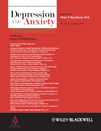SUSTAINED NEURAL ALTERATIONS IN ANXIOUS YOUTH PERFORMING AN ATTENTIONAL BIAS TASK: A PUPILOMETRY STUDY
Abstract
Background
Biased attention patterns have been observed at early (16–500 ms poststimulus onset) and intermediate (1,500–4,000 ms post-onset) time points in anxious youth, but it is unclear whether a more sustained form of neural attentional bias, persisting well beyond the time frame of stimulus presentation and behavioral response, is also apparent. We investigated early, intermediate, and sustained forms of bias using behavioral measures and pupillary reactivity, an index of cognitive and affective load, to gain insight into potential neurocognitive targets for early intervention.
Method
Twenty nonanxious youth and 74 youth with generalized anxiety disorder (GAD), separation anxiety disorder (SAD), and/or social phobia (SP) completed a dot-probe task, which requires participants to respond to a dot replacing either a neutral or fearful face. Emotional faces were presented for short/early (200 ms) or intermediate (2 s) intervals and followed by a sustained (up to 10.5 s) poststimulus interval. Pupil dilation, gaze direction, and reaction times (RTs) were measured during task completion.
Results
Early and intermediate vigilance patterns in RTs and an avoidant pattern in gaze direction were observed in all participants irrespective of anxiety. Sustained pupil dilation in anxious youth was observed on trials in which the dot replaced fearful faces, along with an inflexible pattern of pupillary responding in comparison to controls.
Conclusion
Sustained cognitive-affective load following emotional face viewing is altered and inflexible in anxious youth. These prolonged alterations extend well beyond the time frame of behavioral attentional bias and may indicate inflexible and insufficient sustained cognitive control. Early interventions targeting these alterations could improve long-term mental health trajectories.




